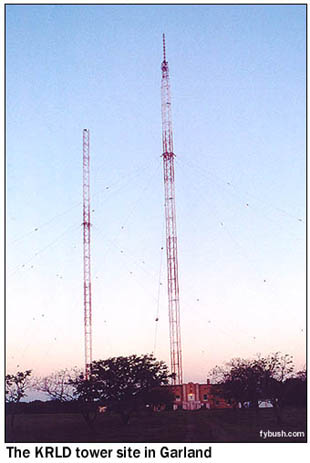 November
14-21, 2002 November
14-21, 2002
"Tower Site" Does Dallas, part III
When we left you last week,
we were near the end of a long day of Dallas tower hunting that
included visits to Cedar Hill, home of most of the market's FM
and TV signals, as well as 61-kilowatt high school station KEOM
and the 12 towers of the KFXR 1190 night site. (Special "Eagle
Eyes" credit to Mike Erickson, who spotted a problem with
KFXR's posted ASRN numbers, one of which had a "6"
where a "9" should have been...)
Next up on the agenda, as the sun headed for the horizon,
was the most powerful AM signal licensed to Dallas (and the second-biggest
AM signal in the market), the 50 kilowatts of KRLD, 1080 on the
dial.
KRLD's calls once stood for "Radio Labs of Dallas,"
and later tied in nicely with the station's owner, the now-defunct
Times Herald newspaper. Before the days of NARBA, KRLD
ran 10,000 watts at 1040 on the dial, under a long-running "Special
Authorization" that gave 1040 to Dallas and to WTIC in Hartford
(this stemmed, I believe, from WTIC's 1934 move to 1040 from
1060, where it had been sharing time with Baltimore's WBAL, which
was itself split between local programming on 1060 and a synchronous
arrangement with New York's WJZ on 760 - but that's a very different
story!)
In any event, KRLD and WTIC both moved to 1080 in 1941 (as
did KWJJ in Portland, Oregon, which had also been on 1040; the
frequency's fourth occupant, WKAR East Lansing MI, became a daytimer
on 870), and KRLD was soon blasting out 50 kilowatts from this
site in Garland, northeast of downtown Dallas, with a pattern
that protected Hartford but covered the southwest very well indeed.
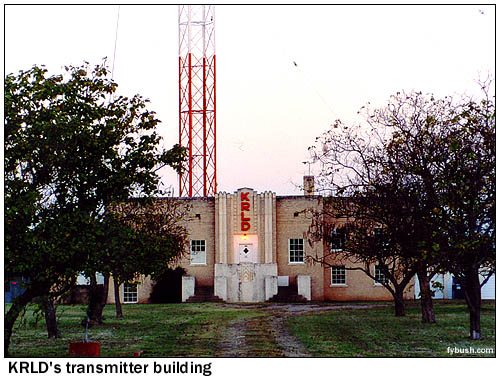 The
top of the daytime tower (they just don't build 'em like that
anymore...) was home to KRLD-TV 4 for a time, before channel
4 joined channel 8 at Cedar Hill in 1955. I don't believe that
KRLD-FM (92.5, later KAFM and now KZPS) ever operated from this
site, but I'd be happy to be proved wrong. The
top of the daytime tower (they just don't build 'em like that
anymore...) was home to KRLD-TV 4 for a time, before channel
4 joined channel 8 at Cedar Hill in 1955. I don't believe that
KRLD-FM (92.5, later KAFM and now KZPS) ever operated from this
site, but I'd be happy to be proved wrong.
(2009 update: And indeed, I was wrong - that old VHF antenna,
which is actually atop the nighttime-only DA tower, belonged
to the FM station and not to Channel 4, according to KRLD CE
Erik Disen, who should know!)
Out at the gate to the site on Saturn Road, deep in the trees,
we can see an old sign that looks as though it once had neon
letters that spelled out "K R L D." Like we said, they
just don't build 'em like that.
This is also the spot where we meet up with Chip Kelley, creator
of 100000watts.com
(now edited by yours truly), who stayed with us through a very
enjoyable dinner.
But before dinner, there's still one more site to take in,
albeit without anything like the history that KRLD has to offer.
The 770 frequency, licensed to Garland, lit up for the first
time in 1990 as KPBC, bringing the calls and religious format
over from Dallas' 1040 daytimer (the historic KIXL, now KGGR).
In 1999, Crawford Broadcasting changed KPBC to KAAM, reviving
for the third time the calls that mean "adult standards"
in Dallas (they began on 1310, whose history we'll explore next
week, then moved to the Plano-licensed 620 signal, moved in from
Wichita Falls, when 1310 went to sports in the mid-nineties,
then were available again when 620 went to Radio Disney as KMKI)
and putting that music back on the air from these five towers
near a church up in Wylie, Collin County, far to the northeast
of Dallas.
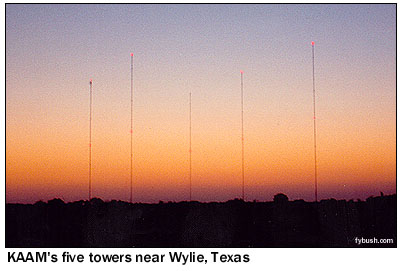 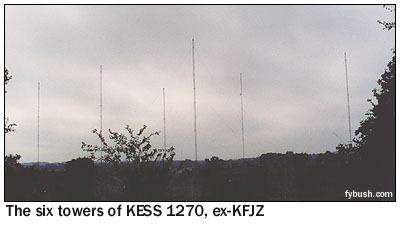
KAAM is our final stop of the night, and after dinner we say
"good night" to Chip, Wally and John and head back
to our hotel for the night. The next morning is gray and dreary,
but there's an entire city to explore yet, so we head west from
Arlington to see what Fort Worth, "Where the West Begins,"
has to offer the tower hunter.
First up, at the north end of Lake Arlington and about a mile
east of the I-820 beltway around Fort Worth, are the six towers
of the 1270 signal, known for decades as KFJZ. Back when Fort
Worth and Dallas were separate radio markets, KFJZ was the top-40
voice of Tarrant County, in an era when KLIF's signal didn't
reach Fort Worth after dark. (KFJZ actually began at 1370 on
the dial back in the twenties; the calls moved to the former
KTAT on 1240 when KFJZ owner Elliott Roosevelt bought KTAT in
1938, and 1240 became 1270 when NARBA took effect in 1941.)
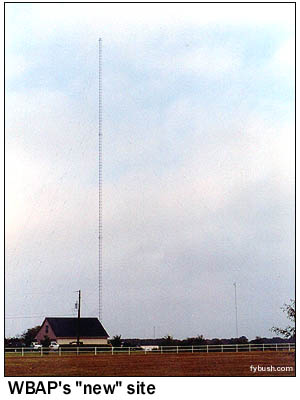 In the eighties,
KFJZ became Spanish KSSA, and then in 1986 a trade of formats
and calls moved KSSA to 94.1 FM and brought the KESS calls over
from the FM, which had been on 93.9 until then. "La Fabulosa
KESS" has been in Spanish here pretty much ever since, except
for a few months as KSBN in 1990-91. In the eighties,
KFJZ became Spanish KSSA, and then in 1986 a trade of formats
and calls moved KSSA to 94.1 FM and brought the KESS calls over
from the FM, which had been on 93.9 until then. "La Fabulosa
KESS" has been in Spanish here pretty much ever since, except
for a few months as KSBN in 1990-91.
From KESS, we head around the southeast corner of Tarrant
County, making a brief detour near the I-820/US 287 interchange
to see the little tower that's home to KK2XDA, the "experimental"
synchronous transmitter that's meant to boost the night signal
of KKDA (730) over in Grand Prairie.
Continuing south to the junction of I-820 and I-20, we head
east briefly on I-20 to pick up US 287 south, past the old transmitter
site of the Fort Worth 1540 signal (nothing left there to
see, apparently) to the "new" transmitter site of WBAP
(820), just south of Turner Warner Road in Bisbee, Texas.
"New," in this case, means about twenty years old;
WBAP's move down to Bisbee in the early eighties (the most recent
move of any I-A clear channel allocation in America, to my knowledge)
ended a long history of sharing transmitter sites with the former
WFAA, Dallas on 570. Until the sixties, of course, WBAP and WFAA
shared more than just a transmitter site; they shared the 820
frequency (and 800 before that), then added the former KGKO,
Wichita Falls (the very first in a long history of Wichita Falls-to-DFW
move-ins) on 570 so that whichever station was not using 820
would have an alternate frequency on which to operate. When WBAP
bought out WFAA's interest in 820 in the sixties, leaving WBAP
alone on 820 and WFAA alone on 570, the stations continued to
share a transmitter site between the two cities on land that
was eventually absorbed by the Dallas-Fort Worth International
Airport.
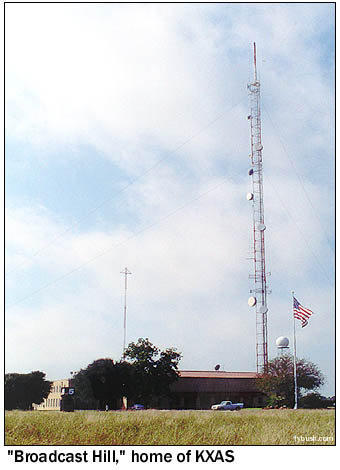 And even after that
site was condemned, WBAP and WFAA continued to share a new site
in Grapevine, until this site went up. As a newish site, it has
a much skinnier tower than KRLD - but you can't argue with the
signal: WBAP has, some say, the largest interference-free U.S.
land coverage of any radio station. And even after that
site was condemned, WBAP and WFAA continued to share a new site
in Grapevine, until this site went up. As a newish site, it has
a much skinnier tower than KRLD - but you can't argue with the
signal: WBAP has, some say, the largest interference-free U.S.
land coverage of any radio station.
From Bisbee, it's back up to I-20, then up I-35W to I-30 so
we can head over to the east side of the city to see where WBAP's
studio was for many years.
"Broadcast Hill" is a rise of land at the end of
Barnett Street, just south of I-30 and a couple of miles east
of downtown Fort Worth, and it was here that Amon Carter, the
owner of the Fort Worth Star-Telegram built his WBAP-TV
(Channel 5) in 1948, the first TV station in Texas.
The studios for WBAP radio and WBAP-FM (96.3) were up here
as well, and for the first decade or so this was the channel
5 transmitter site, too. (Only the threat of losing the NBC affiliation
forced Carter to move the transmitter from his beloved Fort Worth
to the Cedar Hill site the Dallas stations were using, or so
we're told.)
The building here is said to be one of the first ever designed
specifically for use as a TV studio, and it's still in use by
KXAS-TV, now an NBC O&O on channel 5. NBC has also been running
Pax affiliate KPXD (Channel 68) from here, and if Telemundo's
KXTX (Channel 39) isn't here yet, it will be soon.
WBAP radio left here in the seventies, when it was sold separately
from the TV station; an outbuilding on the property was later
home to KFWT (Channel 21), which didn't make it, and KFWT-FM
(97.1), later KFWD-FM and now KEGL - but that, too, is a different
story.
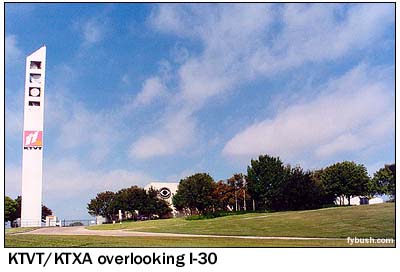 About a mile east
of KXAS, on the north frontage road ("Bridge Street")
of I-30, sits the studio of the market's CBS affiliate, KTVT
(Channel 11) and UPN affiliate, KTXA (Channel 21). About a mile east
of KXAS, on the north frontage road ("Bridge Street")
of I-30, sits the studio of the market's CBS affiliate, KTVT
(Channel 11) and UPN affiliate, KTXA (Channel 21).
Channel 11's history goes back to 1955, when it went on the
air as independent KFJZ-TV. In 1960, the station became KTVT
and in 1962 changed hands to Oklahoma Publishing, aka Gaylord,
which would run it for more than three decades.
In that time, KTVT would become a regional superstation for
the southwest, with cable carriage that extended throughout Texas
and adjoining states and eventually a national reach on satellite.
And then, in 1995, KDFW (Channel 4) dropped the CBS affiliation
to become a Fox O&O, and that left the Eye scrambling for
a new Dallas home. KTVT was the logical choice, and Gaylord was
happy to take on CBS if it would also affiliate with its Seattle
outlet, KSTW (Channel 11), and so the deal was done and KTVT
started its new life. CBS bought out Gaylord in 1999, and the
CBS-Viacom merger brought KTXA into the family a year later -
and KTVT has remained mired far behind the other commercial VHF
stations in the ratings all along.
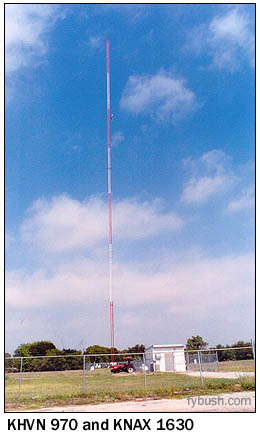 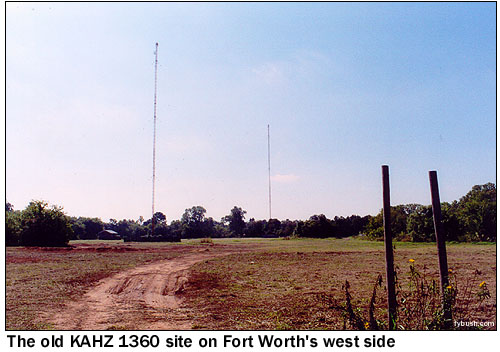
In the meantime, we're off again, taking I-30 west through
downtown and over to the west side of town to check out a newly
silenced site.
The Fort Worth 1360 signal, historically KXOL, used this site
in the River Oaks neighborhood for decades. (KXOL became KWJS
in 1976 under Jimmy Swaggart's ownership, then KNRB in 1988 and
KAHZ a few years later when "Radio Aahs" - remember
them? - took over).
Today it's silent, 1360 having just moved to that new six-tower
site we were looking at back in Part I, and we assume this piece
of land will eventually be redeveloped for some other purpose.
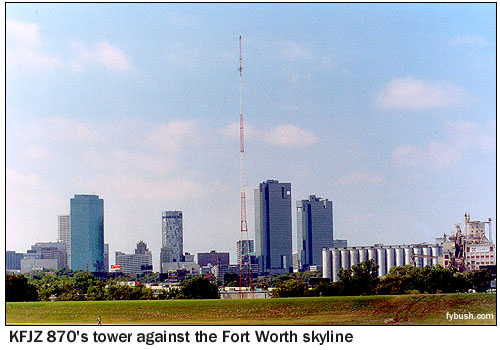 Moving
along to the "Bonnie Brae" neighborhood up on the north
side of town (there's even a "Bonnie Brae Avenue" here,
just like the address of NERW Central!), we see the single stick
of KHVN (970, once the urban station in Fort Worth as KNOK) and
its new X-bander, KNAX (1630), then head for downtown. Moving
along to the "Bonnie Brae" neighborhood up on the north
side of town (there's even a "Bonnie Brae Avenue" here,
just like the address of NERW Central!), we see the single stick
of KHVN (970, once the urban station in Fort Worth as KNOK) and
its new X-bander, KNAX (1630), then head for downtown.
Approaching the city on Fourth Street, there's a nifty view
from the bridge over the west fork of the Trinity River: the
single stick of KFJZ (870) against the downtown skyline a mile
or so to the west.
The KFJZ calls are a recent arrival at this frequency; for
most of its history, 870 in Fort Worth was KJIM, playing country
and big band music. It wasn't until 1984 that the KFJZ calls
moved here from 1270, where they're now associated with a regional
Mexican format as "La Pantera."
(The KJIM calls found a good home, too, moving to AM 1500
up in Sherman, where the current KJIM is about the only local
sound in a market whose local stations have all moved south to
become Dallas rimshotters.)
And down by the base of the tower, one more surprise: a nifty
old building with the KFJZ calls painted on the front wall!
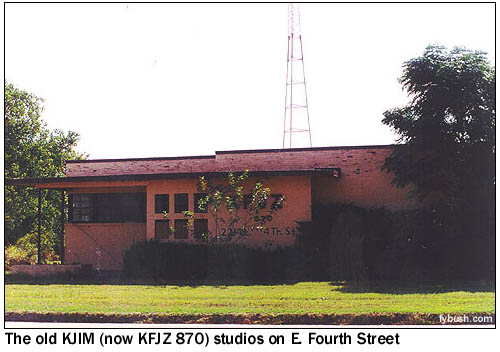 After
this, it's time for lunch, and we go where we've been told: Joe
T. Garcia's Mexican Restaurant in the Stockyards district north
of downtown. There's nothing like good Mexican food in Texas,
and the meal is plenty satisfying. After
this, it's time for lunch, and we go where we've been told: Joe
T. Garcia's Mexican Restaurant in the Stockyards district north
of downtown. There's nothing like good Mexican food in Texas,
and the meal is plenty satisfying.
Downtown Fort Worth isn't bad, either; in fact, it's downright
hopping on this Saturday afternoon, with lots of people on the
streets and far more activity than we expect to find in a Southwest
city's downtown on the weekend.
But we still have more towers to see before this day is through,
so we head east again on Texas 183, past DFW airport and right
to the Dallas/Tarrant county line to see what's happened to that
1540 signal that wasn't down in Kennedale anymore.
1540 was historically KCUL ("Luck" spelled backwards!),
then KBUY playing country. From the seventies until the nineties,
it went through a flurry of calls and formats: KRXV, KMZK, KUQQ,
KTIA, KMIA, KSVZ, KSGB, KTNO and KPAD, mostly doing either Spanish
or religion (or both), before landing in the hands of Entravision
under current calls KZMP.
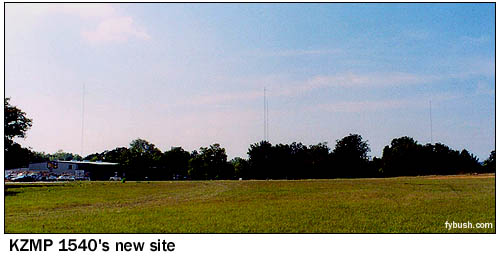 Today's KZMP runs
50 kilowatts by day and 890 watts at night from these four towers
just south of Rock Island Road and west of Belt Line Road; it's
now licensed to University Park instead of Fort Worth, and it
was off the air most of that particular weekend. (Its regional
Mexican format is also heard on KZMP-FM, 101.7 Azle, one of the
many move-ins north of Dallas/Fort Worth.) Today's KZMP runs
50 kilowatts by day and 890 watts at night from these four towers
just south of Rock Island Road and west of Belt Line Road; it's
now licensed to University Park instead of Fort Worth, and it
was off the air most of that particular weekend. (Its regional
Mexican format is also heard on KZMP-FM, 101.7 Azle, one of the
many move-ins north of Dallas/Fort Worth.)
And speaking of "north," that's where we're headed
next; join us next week to see the sites of Grapevine, a jaunt
to Denton and beyond, and a few more downtown studio sites. See
you then!
Special thanks to WFAA transmitter
engineer Don Guemmer, Wally Wawro, John Callarman, Chris Huff
of KSCS, Wayne Kube at Belo corporate, and KRLD's Tyler Cox!
Also be sure to check out Mike Shannon's excellent Dallas radio
history pages at www.knus99.com,
and Steve Eberhart's amazingly comprehensive History
of KLIF site...
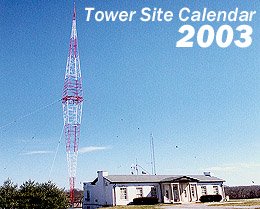 Want to see the other big 1080? WTIC
is one of the more than a dozen Tower Site images featured in
the 2003 Tower Site Calendar, coming this fall from Tower Site
of the Week and fybush.com. Want to see the other big 1080? WTIC
is one of the more than a dozen Tower Site images featured in
the 2003 Tower Site Calendar, coming this fall from Tower Site
of the Week and fybush.com.
If you liked last year's edition, you'll love this one: higher-quality
images (in addition to Avon Mountain, this year's edition includes
Providence's WHJJ; Mount Mansfield, Vermont; Buffalo's WBEN;
KOMA in Oklahoma City; the legendary WSM, Nashville; Brookmans
Park, England; WPAT, Paterson; Four Times Square, New York; WIBC
in Indianapolis; WWVA in Wheeling, W.V.; WGN Chicago and more),
more dates in radio history, a convenient hole for hanging -
and we'll even make sure all the dates fall on the right days!
This year's calendar will go to press very soon, and if you
order now, you'll have yours in hand by late November, in plenty
of time for the holidays. And this year, you can order with your
Visa, MasterCard, Discover or American Express by using the handy
link below!
Better yet, here's an incentive to make your 2003 NERW/Site
of the Week subscription pledge a little early: support NERW/fybush.com
at the $60 level or higher, and you'll get this lovely calendar
for free! How can you go wrong? (Click here
to visit our Support page, where you can make your NERW contribution
with a major credit card...)
You can also order by mail; just send a check for $16
per calendar (NYS residents add 8% sales tax), shipping included,
to Scott Fybush, 92 Bonnie Brae Ave., Rochester
NY 14618.
Thanks for your support!
|